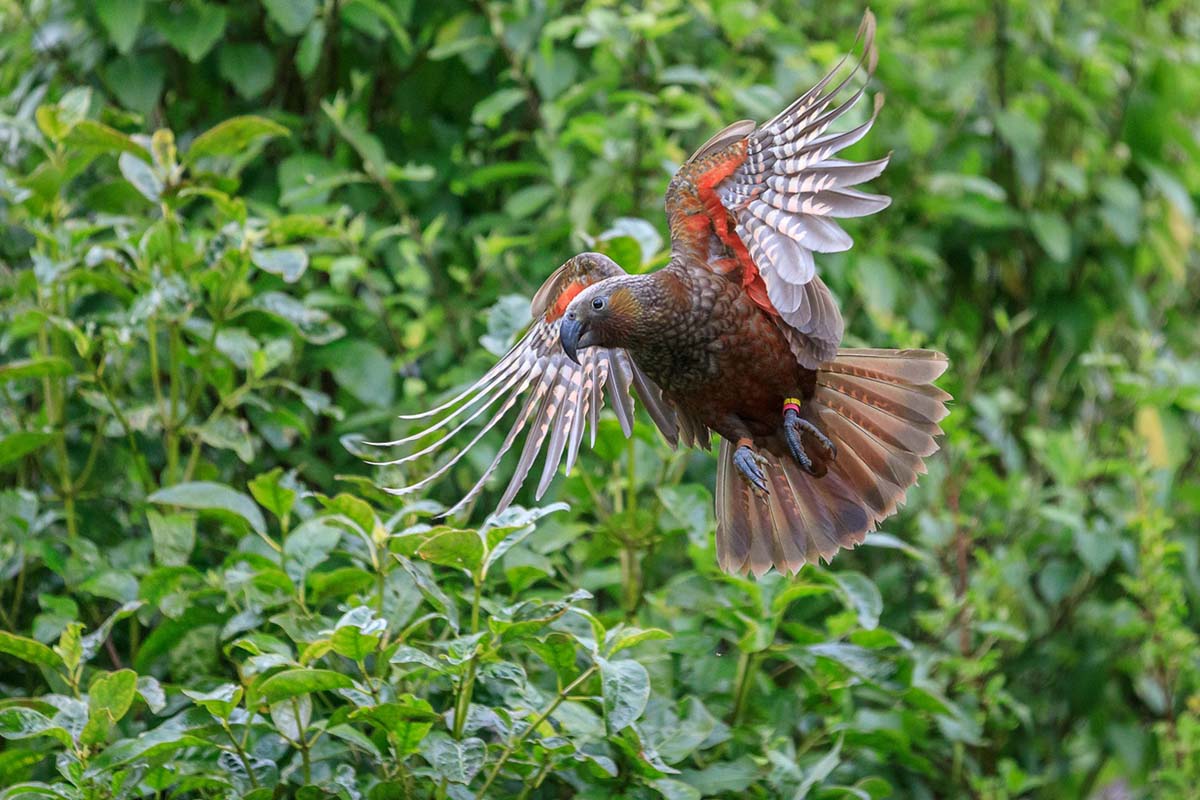Visit ancient species in the heart of the city
Set in the heart of Wellington, New Zealand's capital city, Zealandia Wildlife Sanctuary is home to more than 40 rare and endangered species.
Developed throughout the 1990s, the 225 hectare sanctuary is fully fenced to protect against the pests introduced by humans that ravaged much of Aotearoa New Zealand's birdlife. Along with mustelids and cats that eat flightless birds, chicks, and eggs, pests like the possum eat through the native vegetation. So the fence is cleverly designed to keep out all pests and enable the reintroduction of native trees and plants, as well as breeding of endangered bird species.
The sanctuary ambitious 500-year plan is to transform the valley back to it's pre-human state.
Ultra rare residents
Among the rare-sidents you can find whilst walking around Zealandia are the following:
Kākā - an endemic (only found in New Zealand) forest parrot, predominately brown in colour with crimson and orange flashes, features a strong curved beak used for stripping bark to access grubs and insects underneath. Since introducing 14 captive bred Kaka from zoos between 2002 and 2007, Zealandia is now home to more than 700 living wild within the reserve and surrounding areas.
Kākāriki - an endemic parakeet, brilliant green in colour with a loud chatter, they were close to extinction but are becoming increasingly seen around Wellington thanks to the breeding programme with Zealandia.
Takahē - an endemic and extremely rare rail bird, blue and green feathering with a distinctive red beak, they were thought to be extinct until re-discovered in 1948. There are less than 350 in existence, and Zealandia has a single pair, Nio and Orbell, who live in the wetlands area.
Tīeke/Saddleback - an endemic medium-sized bird with black feathering and a distinctive copper ‘saddle’ on its back and red fleshy wattles at base of its bill, this poor flyer was extinct from the mainland following the spread of rats and cats in the 1800s. They are now in recovery, and a nesting pair has even been found outside of the sanctuary.
Hihi - the sole remaining representative of the Notiomystidae family, the endemic 'Stitchbird' is a small sparrow-sized bird with females olive coloured and males bright blue and yellow. Nesting in tree cavities made them susceptible to rats, stoats, and cats, leaving them extinct on the mainland from 1885 until reintroduced into Zealandia in 2005.
Tuatara - the sole remaining representative of the Rhynchocophalian family, with all other member becoming extinct 65 million years ago, New Zealand's endemic dinosaur is something of a celebrity. This small, scaly, reptillian has a third eye beneath the skin atop their heads and are thought to live for more the 100 years in age.
Can you spot them?
There are no segregated zones and certainly no averies in Zealandia, so finding the rare and endangered species of birds and reptiles can be quite time consuming.
To make the most of your Zealandia experience, it is advisable to book into one of the many tours that run throughout the day and some evenings.
Zealandia's experienced guides will help you find rare and endangered species, and tell you everything you could wish to know about their history, their threatened status, and the breeding programmes that are being run to save them.

Day Time Sanctuary Tour
2-hour guided tour
Join one of Zealandia's experienced guides on a journey of discovery deep inside the sanctuary's woodland.
Your guide will use their incredible knowledge of birdsong, habitats, and local flora to track down even the rarest of the eco-sanctuaries unique animals. Learn the history of each species' decline, the challenges they face, and the efforts being made to save them from extinction within the park while your guide will be tracking down rare and endangered species.
Getting there
You can add a Zealandia Half Day tour when you book one of the following through our Travel Centre:
